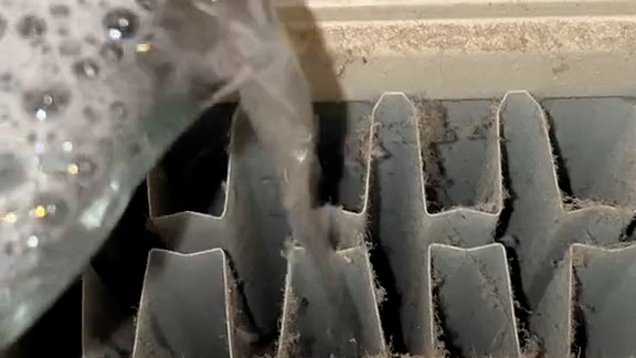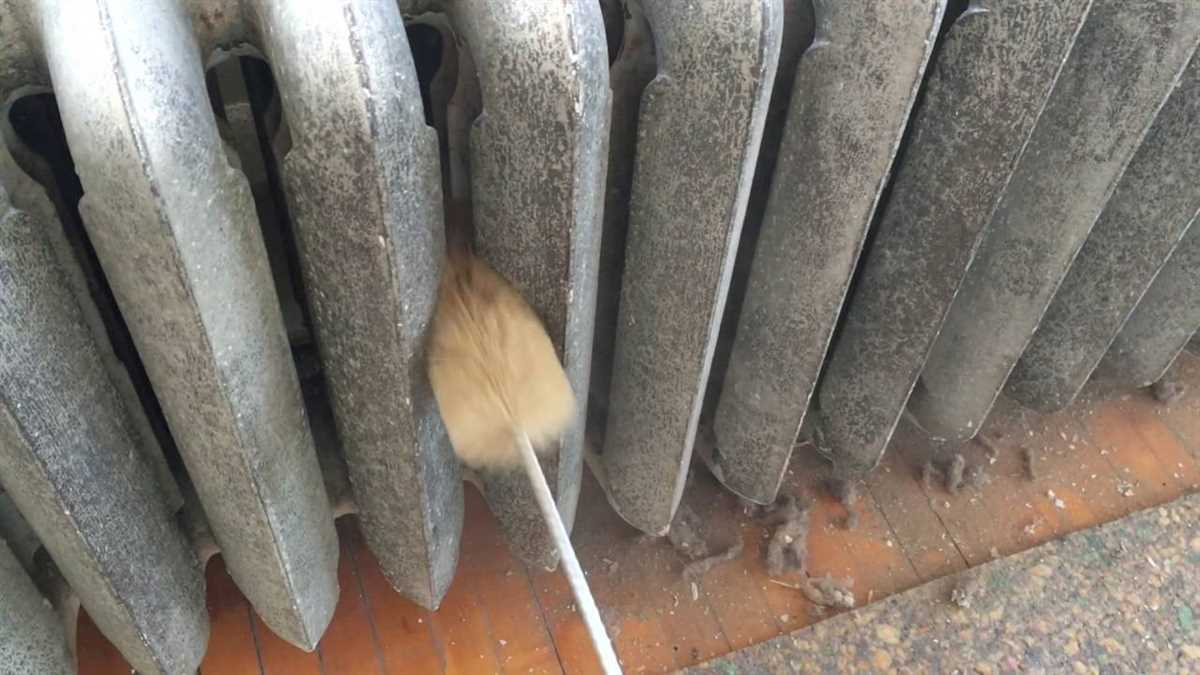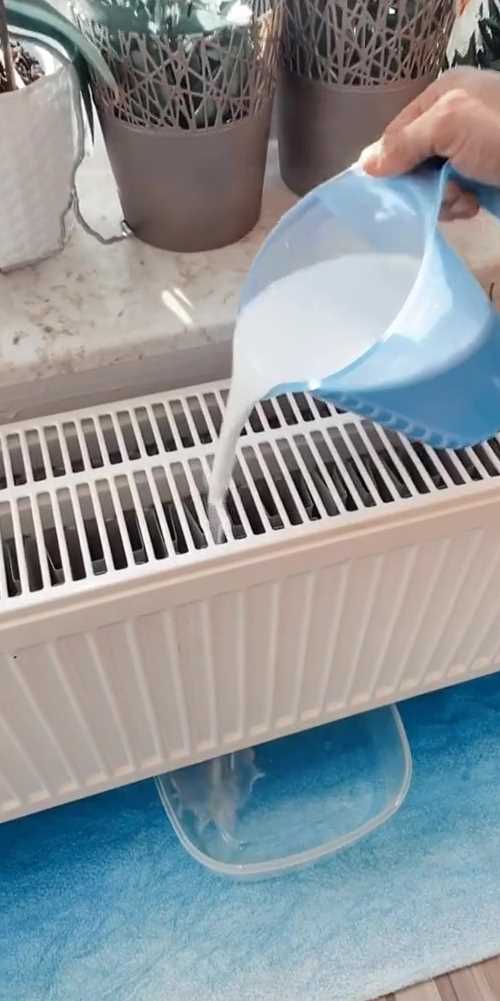
Keeping your home clean and tidy can be a challenging task, especially when it comes to hard-to-reach areas like behind radiators. Dust, dirt, and debris tend to accumulate in these hidden spaces, making regular cleaning essential for maintaining a healthy indoor environment. In this article, we will provide you with expert tips and easy methods to effectively clean behind radiators.
Firstly, it is important to ensure your safety before undertaking any cleaning task. Turn off the radiator and let it cool down before attempting to clean behind it. This will prevent any potential burns and make the process much safer. Additionally, it is advised to wear protective gloves and a face mask to minimize the exposure to dust and allergens.
One common method to clean behind radiators is using a vacuum cleaner with a long, flexible attachment. Start by removing any loose debris or visible dirt with a handheld brush or cloth. Then, attach the long nozzle to your vacuum cleaner and carefully reach behind the radiator. Move the attachment in a gentle, back-and-forth motion to effectively collect the dust and particles.
Alternatively, you can use a microfiber duster or a thin, bendable brush to clean behind the radiator. These tools are specifically designed to reach narrow spaces and can easily maneuver around the pipes and fins. Simply insert the duster or brush behind the radiator and gently swipe it from side to side, making sure to cover the entire area.
Remember to clean the front and top of the radiator as well, as dust tends to settle on these surfaces too. Use a damp cloth or a specialized radiator cleaning brush to wipe away the dirt and grime. Regular maintenance and cleaning will not only improve the efficiency of your radiator but also contribute to a healthier environment for you and your family.
In conclusion, cleaning behind radiators is an important aspect of home maintenance. By following these expert tips and using easy and effective methods, you can keep this hard-to-reach area clean and free of dust and debris. Don’t forget to prioritize safety and wear protective gear during the cleaning process. A clean and well-maintained radiator will not only enhance the overall appearance of your home but also contribute to a more efficient heating system.
Expert Tips on How to Clean Behind Radiators
1. Gather your supplies

Before you begin, gather the necessary supplies to clean behind your radiators. You will need:
- Dust brush or vacuum cleaner with a brush attachment
- Microfiber cloth or duster
- All-purpose cleaner or vinegar solution
- Old toothbrush or small scrub brush
2. Turn off the heating
Before you start cleaning, turn off the heating to ensure that the radiator is cool and safe to clean.
3. Remove any visible dust or debris

Using a dust brush or vacuum cleaner with a brush attachment, remove any visible dust or debris from the back of the radiator. Be careful not to damage the fins or any delicate parts.
4. Dust the back of the radiator
Use a microfiber cloth or duster to gently remove any remaining dust from the back of the radiator. Start at the top and work your way down, making sure to reach all the nooks and crannies.
5. Clean with an all-purpose cleaner or vinegar solution
If there are any stubborn stains or grease on the back of the radiator, spray an all-purpose cleaner or vinegar solution onto a cloth and gently wipe it away. Be careful not to get the radiator wet or use too much liquid.
6. Pay attention to hard-to-reach areas
Use an old toothbrush or small scrub brush to clean any hard-to-reach areas, such as the spaces between the fins or the grooves in the back panel of the radiator. Be gentle to avoid damaging the radiator.
7. Vacuum any remaining dust or debris
Use a vacuum cleaner with a brush attachment to carefully vacuum any remaining dust or debris from the back of the radiator. This will help ensure that all the dirt is completely removed.
8. Place a barrier to prevent future dust accumulation
To prevent dust from accumulating behind the radiator in the future, consider placing a barrier, such as a sheet of cardboard or a foil-covered foam board, between the wall and the back of the radiator.
9. Regularly maintain and clean your radiators
To keep your radiators in good condition and prevent dust buildup, make sure to regularly maintain and clean them. Dust the front and back of the radiators, clean the vents, and check for any leaks or issues.
10. Safety precautions

When cleaning behind radiators, always exercise caution and follow proper safety precautions. Make sure the radiator is turned off and cool before cleaning, and never use excessive force or harsh chemicals that could damage the radiator.
By following these expert tips, you can effectively clean behind radiators and improve the overall efficiency and appearance of your heating system.
The Importance of Cleaning Behind Radiators
Cleaning behind radiators is an important task for maintaining a clean and healthy home. Over time, dust, dirt, and debris can accumulate behind radiators, reducing their efficiency and impacting the air quality in your living space. Here are some reasons why cleaning behind radiators is essential:
- Improved Air Quality: As dust and dirt accumulate behind radiators, they can become a breeding ground for allergens and irritants. Cleaning behind radiators ensures that the air circulating in your home is clean and free from these particles.
- Optimal Heating Efficiency: When dust and debris build up behind radiators, they can restrict the airflow and reduce the heat output. By regularly cleaning behind radiators, you can ensure that they operate at their full potential, effectively warming your home.
- Prevention of Fire Hazards: Dust and debris are combustible materials that can pose a fire risk when they accumulate behind radiators. Regular cleaning helps prevent the buildup of these flammable particles and reduces the risk of a fire starting.
- Extended Lifespan of Radiators: Radiators that are clogged with dust and debris have to work harder to generate heat, putting additional strain on the components. Cleaning behind radiators helps to prolong their lifespan and prevent potential breakdowns or costly repairs.
Overall, cleaning behind radiators is a necessary maintenance task that should not be overlooked. Regularly removing the dust and debris from behind radiators not only improves air quality but also promotes the efficient functioning of your heating system, reduces fire hazards, and extends the lifespan of your radiators.
Preventing Dust and Debris Build-up
1. Regular Dusting

To prevent dust and debris build-up behind radiators, it is important to regularly dust the area. Use a long-handled duster or a microfiber cloth to reach behind the radiator and remove any accumulated dust. You can also use a vacuum cleaner with a brush attachment to effectively remove dust particles.
2. Vacuuming
In addition to dusting, vacuuming is another effective method to prevent dust and debris build-up behind radiators. Use a vacuum cleaner with a narrow attachment or a crevice tool to reach into the tight spaces behind radiators and suck out any dirt or debris.
3. Air Purifiers
Using an air purifier in the room can help reduce the amount of dust and debris that accumulates behind radiators. Air purifiers work by trapping airborne particles, including dust, pet dander, and pollen, helping to maintain cleaner air and prevent build-up behind radiators.
4. Sealing Gaps
Sealing any gaps or cracks around the radiator can help prevent dust and debris from entering the space behind it. Use caulk or weatherstripping to seal any openings, ensuring a tight fit between the radiator and the wall. This will minimize the amount of dust that can accumulate behind the radiator.
5. Rearrange Furniture
Furniture placed too close to radiators can obstruct the airflow and contribute to dust and debris build-up. To prevent this, make sure to keep furniture a few inches away from radiators to allow proper air circulation and make cleaning behind the radiators easier.
6. Installing Radiator Covers
Radiator covers can be a practical solution to prevent dust and debris from settling behind radiators. These covers act as a shield, preventing particles from accumulating behind the radiator and making cleaning more manageable. Choose a radiator cover that is easy to remove for regular cleaning.
7. Professional Cleaning

If you find it difficult to clean behind radiators yourself or notice excessive dust and debris build-up, consider hiring a professional cleaning service. Professional cleaners have the tools and expertise to thoroughly clean the area and remove any accumulated dirt, ensuring optimal radiator performance.
By following these preventive measures, you can minimize dust and debris build-up behind radiators, ensuring they operate efficiently and maintain cleaner air in the room.
Effective Methods for Cleaning Behind Radiators
1. Dusting and Vacuuming
One of the most common methods for cleaning behind radiators is dusting and vacuuming. Here’s how to do it:
- Start by turning off the radiator and allowing it to cool down completely.
- Use a long-handled duster or a vacuum cleaner with a narrow attachment to remove any visible dust or debris from the radiator’s exterior.
- Next, gently slide the duster or vacuum attachment behind the radiator to reach the hard-to-reach areas. Be careful not to damage any components or fins.
- Move the duster or vacuum attachment back and forth to collect any dust or dirt.
- Repeat the process on both sides of the radiator until you’ve thoroughly cleaned the area behind it.
2. Using a Radiator Brush
If the dusting and vacuuming method didn’t completely clean behind your radiator, you can try using a radiator brush. Follow these steps:
- Turn off the radiator and wait for it to cool down.
- Insert the radiator brush into the space between the radiator and the wall.
- Gently scrub the brush back and forth to loosen any dust or dirt.
- Afterward, use a vacuum cleaner or duster to remove the loosened debris.
3. Steam Cleaning
If you prefer a more thorough cleaning method, you can consider using a steam cleaner. Here’s how:
- Turn off the radiator and allow it to cool.
- Fill a steam cleaner with water according to the manufacturer’s instructions.
- Direct the steam nozzle towards the area behind the radiator and apply steam. Be cautious of any electrical connections.
- As the steam dissolves the dirt and grime, wipe the area gently with a microfiber cloth or a sponge.
- Repeat the process until the area is clean.
4. Hiring a Professional Cleaner
If you’re unable to clean behind your radiators on your own or want a more comprehensive cleaning, you can consider hiring a professional cleaner. They have the necessary tools and expertise to get the job done effectively.
Remember, regular cleaning behind radiators is essential for maintaining proper heat circulation and preventing the buildup of dust and debris. By following these effective cleaning methods, you can ensure your radiators function optimally.+
Using Household Items for Cleaning

Cleaning behind radiators can be tricky, but with a few household items, the task becomes quite manageable. Here are some effective methods to clean behind radiators using items you likely already have at home:
1. Vacuum Cleaner

One of the easiest ways to clean behind radiators is to use a vacuum cleaner with a narrow attachment. Simply attach the narrow nozzle or crevice tool to the vacuum cleaner hose and carefully vacuum the dust and debris from behind the radiator.
2. Long-Handled Brush
If you don’t have a vacuum cleaner, a long-handled brush can also do the trick. Use a brush with soft bristles to reach behind the radiator and gently sweep away any dust or cobwebs.
3. Microfiber Cloth
A microfiber cloth is an excellent tool for cleaning behind radiators. Simply wrap the cloth around a long, thin object like a ruler or wooden dowel, and carefully slide it behind the radiator to wipe away dust and dirt.
4. Paintbrush
A clean, dry paintbrush can be used to reach narrow spaces and remove dust from behind radiators. Gently brush the bristles between the radiator fins to dislodge any trapped dirt or debris.
5. Silicone Oven Mitt
If you’re having trouble reaching behind the radiator, try using a silicone oven mitt. Slip your hand into the mitt and use it to reach behind the radiator and wipe away dust and dirt easily.
6. Vinegar Solution
If you encounter stubborn dirt or grime, mix equal parts white vinegar and water in a spray bottle. Spray the solution behind the radiator and let it sit for a few minutes. Then, use a cloth or brush to wipe away the loosened dirt.
7. Toothbrush
A toothbrush with soft bristles can be used to get into tight spaces and clean hard-to-reach areas behind radiators. Dip the toothbrush in a mixture of warm water and mild detergent and gently scrub away any dirt or grime.
Remember to always turn off the radiator and allow it to cool down before attempting to clean behind it. Safety should be your top priority.
By using these simple household items, you can effectively clean behind radiators and ensure better air quality in your home.
Hiring Professional Help
If you don’t have the time or the expertise to clean behind your radiators yourself, hiring professional help can be a great option. Professional cleaners have the knowledge and experience to effectively clean hard-to-reach areas like behind radiators.
Here are a few benefits of hiring professional help for cleaning behind radiators:
- Efficiency and expertise: Professional cleaners are trained to efficiently clean difficult areas and have the necessary tools and equipment to do the job effectively.
- Thorough cleaning: They have the expertise to ensure that every nook and cranny is thoroughly cleaned, removing dust, dirt, and debris.
- Time-saving: Hiring professionals can save you time and effort, allowing you to focus on other important tasks.
- Reduced risk of damage: Professionals know how to clean behind radiators without causing any damage to the heating system or surrounding areas.
When hiring professional help, make sure to do your research and choose a reputable cleaning company with experience in cleaning radiators. You can ask for recommendations from friends, read online reviews, or request quotes from multiple companies to compare their services and prices.
Remember, hiring professionals may come with a cost, so it’s important to consider your budget and the value you place on your time and convenience. Ultimately, the decision to hire professional help or clean behind radiators yourself depends on your personal preferences and circumstances.
FAQ
How often should I clean behind radiators?
It is recommended to clean behind radiators at least once a year. However, if you have pets or suffer from allergies, it is best to clean behind radiators more frequently, around every 3-6 months.
What tools do I need to clean behind radiators?
To clean behind radiators, you will need a vacuum cleaner with a long nozzle attachment, a microfiber cloth, a duster with an extendable handle, and a brush with soft bristles. Additionally, you may also need a screwdriver to remove the radiator cover if necessary.
How do I clean behind radiators without removing them?
To clean behind radiators without removing them, you can use a vacuum cleaner with a long nozzle attachment to reach the dust and debris. You can also use a duster with an extendable handle or a microfiber cloth wrapped around a ruler or a piece of cardboard to reach the narrow spaces. Remember to be gentle and avoid damaging the radiator fins.
Can I use water to clean behind radiators?
It is not recommended to use water to clean behind radiators, especially if they are electric or if you have a central heating system. Water can cause damage to the electrical components and pipes. Instead, use a vacuum cleaner or a duster with an extendable handle to remove dust and debris.












